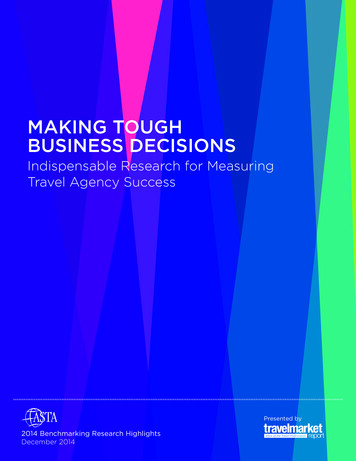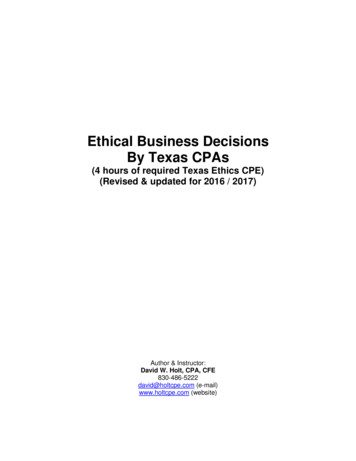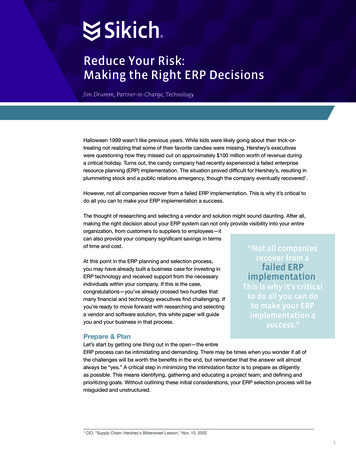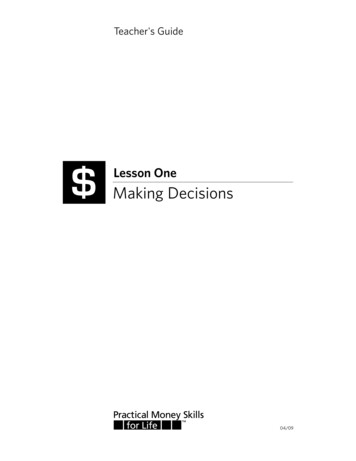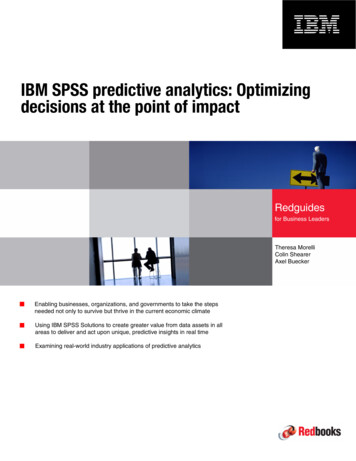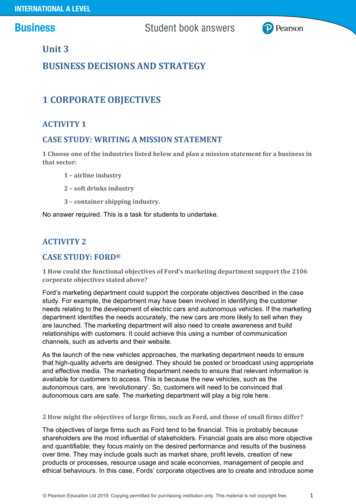
Transcription
Unit 3BUSINESS DECISIONS AND STRATEGY1 CORPORATE OBJECTIVESACTIVITY 1CASE STUDY: WRITING A MISSION STATEMENT1 Choose one of the industries listed below and plan a mission statement for a business inthat sector:1 – airline industry2 – soft drinks industry3 – container shipping industry.No answer required. This is a task for students to undertake.ACTIVITY 2CASE STUDY: FORD 1 How could the functional objectives of Ford’s marketing department support the 2106corporate objectives stated above?Ford’s marketing department could support the corporate objectives described in the casestudy. For example, the department may have been involved in identifying the customerneeds relating to the development of electric cars and autonomous vehicles. If the marketingdepartment identifies the needs accurately, the new cars are more likely to sell when theyare launched. The marketing department will also need to create awareness and buildrelationships with customers. It could achieve this using a number of communicationchannels, such as adverts and their website.As the launch of the new vehicles approaches, the marketing department needs to ensurethat high-quality adverts are designed. They should be posted or broadcast using appropriateand effective media. The marketing department needs to ensure that relevant information isavailable for customers to access. This is because the new vehicles, such as theautonomous cars, are ‘revolutionary’. So, customers will need to be convinced thatautonomous cars are safe. The marketing department will play a big role here.2 How might the objectives of large firms, such as Ford, and those of small firms differ?The objectives of large firms such as Ford tend to be financial. This is probably becauseshareholders are the most influential of stakeholders. Financial goals are also more objectiveand quantifiable; they focus mainly on the desired performance and results of the businessover time. They may include goals such as market share, profit levels, creation of newproducts or processes, resource usage and scale economies, management of people andethical behaviours. In this case, Fords’ corporate objectives are to create and introduce some Pearson Education Ltd 2019. Copying permitted for purchasing institution only. This material is not copyright free.1
important new products in the next few years. For example, electric vehicles andautonomous cars.In contrast, small enterprises may have a wide variety of objectives. These might include thefollowing: ensuring that the company breaks even at the end of the year improving the firm’s cash flow in the next three months increasing sales by 25 per cent over the next three years recruiting two new staff with skills in sales marketing to have an important influence on markets reducing energy consumption by 5 per cent making more use of recyclable materials in production.Clearly, there are similarities between the objectives of small and large businesses.However, large businesses will have to please more stakeholders and will also tend to bemore ambitious.ACTIVITY 3APPRAISING MISSION STATEMENTS1 What is the purpose of each of the statements?(a) RWDC’s mission statement aims to ensure that all employees understand theintention to keep progressing as a business through ‘increasing shared experiencesand customer fun’. This mission statement is clearly focused on the actual productsthey develop and how they intend to stay at the ‘cutting edge’ with continuousdevelopment.(b) PM Camping’s mission statement is targeted at both internal and externalstakeholders. The mention of ‘trust’ and ‘co-operation’ indicate that this business hasa clear ethical stance that it wants to share with its stakeholders.(c) Thomas Therapeutics and Pharmacy’s mission statement is very clear andcommunicates exactly what the business does. The purpose of this missionstatement might be to clarify the purpose of the business to potential customers andsuppliers.2 Who are the intended audiences?(a) RWDC’s mission statement is targeted at employees and customers.(b) PM Camping’s mission statement is a guideline for how they want their employees todo business.(c) Thomas Therapeutics and Pharmacy’s mission statement is intended for potentialcustomers and suppliers. Pearson Education Ltd 2019. Copying permitted for purchasing institution only. This material is not copyright free.2
EXAM PRACTICECASE STUDY: LEGO CORPORATE OBJECTIVES1 Define the term ‘corporate objective’. (2 marks)A corporate objective is one set by the directors of a medium to large-sized business andcomes from the company’s aims and mission statement. One of LEGO’s corporate objectiveswas to support the learning of 101 million children by 2015.2 Explain one reason LEGO might have for setting an objective to achieve 100 per centrenewable energy by 2020. (4 marks)By setting a target of using 100 per cent renewable energy by 2020, LEGO will become asustainable business. It will not exploit the world’s natural resources and will minimise itscarbon footprint. This will send a strong message to its customers and consumers that thecompany feels it is important to think about the long-term impact of operating a globalbusiness. LEGO focuses on educating children and so this objective has the potential toeducate children about the importance of the environment.Setting this objective will help to will build LEGO’s reputation as an ethical and sociallyresponsible organisation.3 Explain one possible reason why LEGO might have a mission statement. (4 marks)LEGO has a mission statement in order to communicate its aims and purpose to allstakeholder groups. A good mission statement clarifies the company’s vision and ambitions.LEGO’s mission statement – ‘to inspire the builders of tomorrow’ – is a simple principle thatall stakeholder groups can understand and relate to. This statement shows customers thatthe product is more than just a toy. It reminds LEGO employees that all of their productsmust be good enough to inspire a younger generation.4 Assess which of the LEGO Group’s corporate objectives is the most important for thelong-term success of the business. (12 marks)LEGO’s corporate objective to ‘support the learning of 101 million children’ is very importantto their long-term success.This is because the objective is clearly linked to the growth of the company and increasingthe number of consumers who can access their educational toys. By achieving this corporateaim, LEGO will increase its market share of the global toy market. This will allow it to becomemore competitive. Also, this corporate objective is closely linked to the company’s missionstatement: ‘to inspire the builders of tomorrow’. Achieving this objective will help LEGO toachieve its overall aim.On the other hand, ‘adopting a zero-waste mindset’ is important to LEGO, as this willimprove production efficiency and maximise capacity utilisation. With lower costs, LEGO willalso increase the contribution per unit. This will help LEGO to maximise profitability andplease its shareholders. However, it seems that LEGO has already achieved this objective,as indicated by the 2014 report. This means that it may not be as important to the long-termsuccess because the target will not motivate employees.Overall, ‘supporting learning for 101 million children’ seems to be the most important of thefive corporate objectives. Apart from being closely aligned to LEGO’s mission statement, it is Pearson Education Ltd 2019. Copying permitted for purchasing institution only. This material is not copyright free.3
the objective that has yet to be achieved, according the 2014 report. The key to achievingthis objective may be how successful LEGO is at expanding into the expanding Asian toymarket as consumers become wealthier in countries such as Malaysia and China. Pearson Education Ltd 2019. Copying permitted for purchasing institution only. This material is not copyright free.4
2 THEORIES OF CORPORATE STRATEGYACTIVITY 1CASE STUDY: ATTA GLOBAL GROUP ️1 Explain how a business might use Ansoff’s Matrix.Ansoff’s Matrix can be used by a business to help develop its corporate strategy. It is adecision-making tool that allows businesses to consider some key factors when deciding ona strategy. These include the level of investment in new and existing products, theexploitation of different markets, the growth strategy of the business and the level of risk abusiness is prepared to accept.The matrix identifies four distinct strategies that a business might consider. The first is to sellmore of its established products in existing markets. This is the least risky strategy because itrequires much lower levels of investment than others. The second is to adopt a strategy ofproduct development. This involves developing new or improved products in existingmarkets. In this case, the Atta Group could develop new metal products to sell in its existingmarkets. This might be relatively risky because new product development can be expensive,especially if new products are not well received.A third strategy is to sell more established products in new markets. In this case, the AttaGroup could sell its current products in new countries. Finally, the riskiest of all strategies isto diversify. This involves developing new products for new markets. It is risky because thebusiness will be operating outside its area of expertise. It will have to compete withestablished and more experienced operators in these new markets.A business can use Ansoff’s Matrix to help decide which of the four distinct strategies mightbe most suitable for its current needs and position. In this case, Atta Group has opted todiversify into property.2 What are the potential benefits of the Atta Group’s diversification strategy to thebusiness?Atta Group has opted for the riskiest of all growth strategies: it has decided to diversify. Thecurrent activities of Atta include the processing of steel coil, tubes, strapping, steel furniture,metal roofing, floor decking, perforated metal and the industrial recycling of scrap metal.However, Atta has decided to try property development. For example, one of its subsidiaries,Tetap Gembira Development, planned a new project on land at Barat Daya, in Penang, in2018. In addition, other companies under its control, Park Avenue Construction andProgerex, have bought a number of double-storey bungalows. In 2018, Atta Group said thatPark Avenue Construction would be purchasing a property company, Sungguh GemilangDevelopment for RM12 million.The diversification strategy adopted by Atta is the riskiest of all growth strategies, accordingto Ansoff’s Matrix. This is because Atta has no previous experience in property development.It will be operating in a completely different market. It will have to compete with existingoperators who will be established and experienced.However, although it is risky, there are considerable benefits if the strategy succeeds. Forexample, it will reduce how much Atta depends on the sale of metal products. Atta will bespreading its risk and increasing its security. Also, according to a spokesperson for AttaGroup, ‘The proposed acquisition is a strategic move in view of the company’s proposed Pearson Education Ltd 2019. Copying permitted for purchasing institution only. This material is not copyright free.5
diversification into property development and would expect to generate synergistic benefits tothe group’. Information in the case study also states that the diversification into property byAtta should contribute over 25 per cent to the group’s profits in the future.If Atta has analysed and evaluated all of the possible risks, costs and benefits to entering thenew market carefully, it is likely that the rewards of diversification will outweigh thedrawbacks. However, this may not be known for a few years. If the attempt does fail, it couldcost Atta severely.ACTIVITY 2CASE STUDY: RED BULL 1 Explain how Red Bull’s corporate strategy relates to Porter’s Strategic Matrix.Porter’s Strategic Matrix helps to identify the sources of competitive advantage that abusiness might achieve in the market. In the matrix, three clear generic strategies areidentified. These are cost leadership, differentiation and focus (on a narrow range ofcustomers). In this case, Red Bull has clearly opted for a differentiation strategy.Red Bull charges a premium price since the brand is perceived to provide consumers withadditional benefits. For example, consuming Red Bull is believed to help people lead a fulland active lifestyle and enhance mental and physical performance. Red Bull’s competitiveadvantages, which help to differentiate the product, include first-mover advantage, a uniquesweet flavour, an association with extreme sports and an effective marketing strategy. RedBull is a market leader in the energy drinks market and its commitment to productdifferentiation has surely helped it to reach and maintain this position over the years.2 What are the potential consequences for Red Bull of not adopting one of Porter’s threegeneric strategies?According to Porter, the consequences of failing to adopt one of the three generic strategiesidentified in his strategic matrix are severe.Porter believed that if a business was ‘stuck in the middle’ with no clear strategy, it wasunlikely to succeed. This might be because without a clear strategy a business will lose focusand fail to follow a clear strategic path. It may not use resources appropriately and fail toachieve a clear position in the market. Customers may become confused and stop buyingthe product. In this case, Red Bull has clearly differentiated its brand from those ofcompetitors. It charges a premium price since the brand is perceived to provide consumerswith additional benefits. Consuming Red Bull is believed to help people lead a full and activelifestyle and enhance mental and physical performance. At the moment, Red Bull is themarket leader following a very clear different
are launched. The marketing department will also need to create awareness and build relationships with customers. It could achieve this using a number of communication channels, such as adverts and their website. As the launch of the new vehicles approaches, the marketing department needs to ensure that high-quality adverts are designed. They should be posted or broadcast using appropriate


